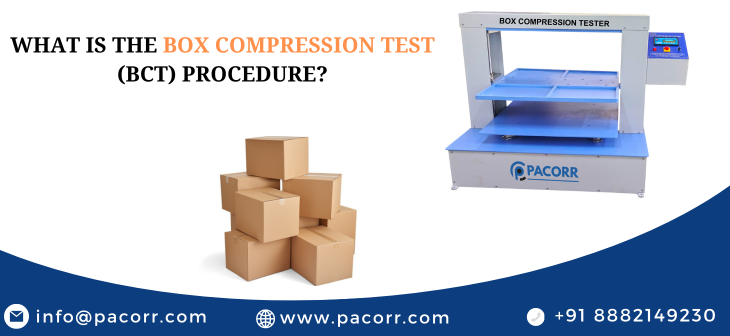
Packaging is an essential element in safeguarding products during storage and transit. To ensure reliability, the Box Compression Test (BCT) is a vital assessment tool used to measure the strength and stability of packaging materials, particularly corrugated boxes. In this comprehensive guide, we will delve into the BCT procedure, its importance, standards such as ASTM D642, ASTM D4169, ISO 2234:2015, EN ISO 12048, and its implementation using specialized equipment like the Box Compression Tester from Pacorr.
The Importance of Box Compression Testing
Box Compression Testing is not merely a regulatory formality but a critical quality assurance practice that ensures packaging can withstand physical stresses during shipping and storage. By understanding the maximum compressive force a box can endure before failing, manufacturers can improve packaging materials and design to prevent product damage and returns.
Standards Governing Box Compression Tests
Several international standards provide the framework for conducting BCT, ensuring consistency and reliability across tests:
- ASTM D642 and ASTM D4169: These American standards guide the testing of the stacking strength of boxes, considering factors like weight distribution and handling.
- ISO 2234:2015: It sets out the methodology for calculating the compression strength of boxes and similar containers.
- EN ISO 12048: This European standard specifies techniques for determining the compression and stacking tests of boxes and other freight containers.
The Box Compression Test Procedure
- Sample Preparation: Select the box for testing, ensuring it represents the batch and is free from damage.
- Equipment Setup: Utilize a Box Compression Tester, like the model from Pacorr, which is designed according to international standards. Adjust the machine settings according to the box dimensions.
- Placing the Box: Position the box correctly on the test platform of the machine.
- Initiating the Test: Start the machine, which applies a compressive force vertically onto the box. The force is increased until the box collapses or reaches the predefined limit.
- Data Recording: Modern testers like Pacorr's digital model provide real-time data display, recording the peak force exerted and the deformation of the box.
- Analysis: Review the data to assess the box's performance against specified standards. This analysis helps in understanding if the packaging can handle the stress it would face during shipping and storage.
Selecting the Right Equipment
Pacorr offers an array of Box Compression Testers equipped with advanced features like digital displays, uniform force distribution, and auto-cut off systems. The choice of the right tester involves considering factors like load capacity, accuracy, and the specific needs of the production environment. Pacorr's models cater to diverse requirements, ensuring precision and reliability in testing.
Maintenance and Calibration
To maintain the accuracy and longevity of the Box Compression Tester, regular maintenance is crucial. This includes routine calibration, greasing moving parts, and keeping the device clean and free from debris, ensuring consistent performance over time.
Enhancing Box Compression Testing with Advanced Features
In addition to standard procedures, Pacorr's Box Compression Tester incorporates advanced technological features that enhance the accuracy and reliability of the tests. Features like high-resolution sensors, automated load application, and intuitive interfaces ensure that even non-expert users can perform tests efficiently and accurately.
The Role of BCT in Sustainability
Sustainability in packaging is becoming increasingly important. By optimizing box designs to use minimal material while maintaining strength, companies can reduce waste and environmental impact. BCT helps in identifying the right balance between material usage and box performance, promoting sustainable packaging solutions.
Integration with Quality Control Systems
Integrating BCT data with broader quality control systems can significantly enhance production workflows. Automated data capture and analysis help in making real-time adjustments to the manufacturing process, improving overall product quality and reducing waste.
Case Studies and Industry Applications
Real-world applications of BCT in industries like electronics, pharmaceuticals, and consumer goods illustrate its importance. For instance, a leading electronics manufacturer used BCT data to redesign their packaging, resulting in a 20% reduction in damage during shipping and significant cost savings.
Future Trends in Packaging Testing
Looking forward, advancements in material science and digital technologies are set to revolutionize how packaging is tested and designed. Innovations such as AI-driven predictive modeling and eco-friendly testing methods are expected to become mainstream, further enhancing the efficiency and sustainability of packaging.
Understanding the Box Compression Test procedure and its implementation through standards like ASTM D642 and ISO 2234:2015 is crucial for manufacturers and quality assurance professionals in the packaging industry. Using robust equipment like Pacorr’s Box Compression Tester ensures that your packaging meets the necessary safety and quality standards, protecting products during transit and storage.

